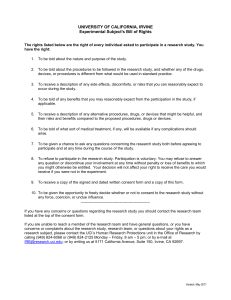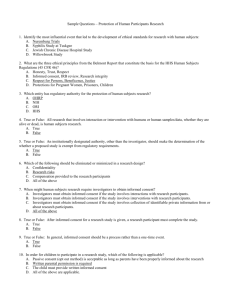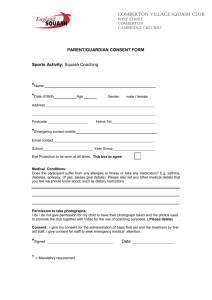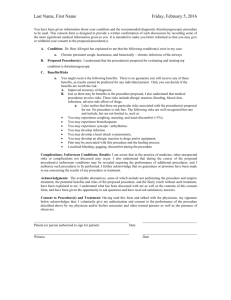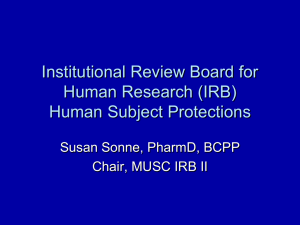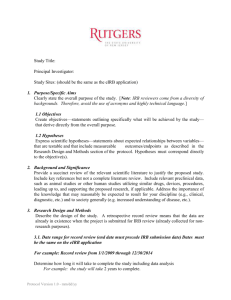Protocol Template for IRB Submission
advertisement
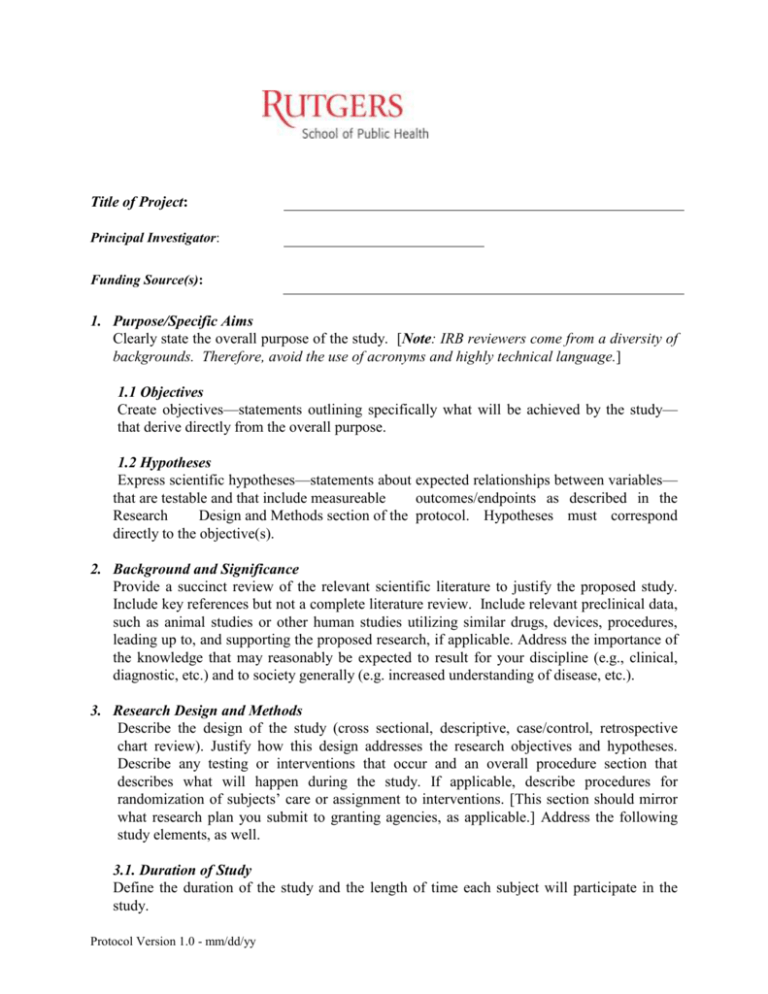
Title of Project: Principal Investigator: Funding Source(s): 1. Purpose/Specific Aims Clearly state the overall purpose of the study. [Note: IRB reviewers come from a diversity of backgrounds. Therefore, avoid the use of acronyms and highly technical language.] 1.1 Objectives Create objectives—statements outlining specifically what will be achieved by the study— that derive directly from the overall purpose. 1.2 Hypotheses Express scientific hypotheses—statements about expected relationships between variables— that are testable and that include measureable outcomes/endpoints as described in the Research Design and Methods section of the protocol. Hypotheses must correspond directly to the objective(s). 2. Background and Significance Provide a succinct review of the relevant scientific literature to justify the proposed study. Include key references but not a complete literature review. Include relevant preclinical data, such as animal studies or other human studies utilizing similar drugs, devices, procedures, leading up to, and supporting the proposed research, if applicable. Address the importance of the knowledge that may reasonably be expected to result for your discipline (e.g., clinical, diagnostic, etc.) and to society generally (e.g. increased understanding of disease, etc.). 3. Research Design and Methods Describe the design of the study (cross sectional, descriptive, case/control, retrospective chart review). Justify how this design addresses the research objectives and hypotheses. Describe any testing or interventions that occur and an overall procedure section that describes what will happen during the study. If applicable, describe procedures for randomization of subjects’ care or assignment to interventions. [This section should mirror what research plan you submit to granting agencies, as applicable.] Address the following study elements, as well. 3.1. Duration of Study Define the duration of the study and the length of time each subject will participate in the study. Protocol Version 1.0 - mm/dd/yy Add protocol title PI name 3.2 Study Sites List all Rutgers and non-Rutgers study sites where research activities will take place, including sites where subjects will be recruited, consent process will take place, treatment will occur, medical records will be accessed and/or stored, and other research-related activities. 3.3 Sample Size Justification Describe total sample size (including gender and minority considerations), expected accrual rates and sampling strategy (justified for testing the primary and/or secondary hypothesis). Power calculations for proposed sample size and endpoints should also be included. Give references for the pilot data and method of sample size calculation. 3.4 Subject Selection Outline subject selection inclusion and exclusion criteria. 3.4.1 Inclusion Criteria Describe the target subject population. Provide all relevant demographic (e.g., age, ethnicity), biomedical (e.g., disease status, laboratory values, pregnancy) and behavioral characteristics (e.g., cognitive abilities, mood) relevant for inclusion and exclusion. [Note: In order to assure all persons equitably share the burdens and benefits of research, scientific objectives, not membership in a privileged or vulnerable group, must guide the development of inclusion criteria.] 3.4.2 Exclusion Criteria Describe what relevant demographic, biomedical or behavioral characteristics exclude persons from participating in your research. Provide clear justification(s) for exclusions. No group of persons—women, pregnant women, children, minorities, non-English speaking persons—should be categorically excluded from the study without a scientific or ethical reason to do so. Note any efforts you will take to overcome any anticipated barriers to participation. [Note: If a study is to offer value to future patients, its results must be generalizable. This means that the sample of subjects selected for the study must be representative of society’s members.] 4. Study Variables 4.1 Independent Variables or Interventions Describe any treatments or interventions to be compared for their effects on participants. Clearly differentiate interventions or procedures that are a part of standard of care from those that are experimental. In the case of chart reviews, indicate if you will be comparing specific treatments or other interventions performed in the past. All procedures and interventions must be consistent with sound research design and should not unnecessarily expose subjects to risks of harm. Protocol Version 1.0 - mm/dd/yy -2- Add protocol title PI name 4.1.1 Drug or Device Interventions Include the regimen (drugs, doses and schedule by which the treatment will be given), and drug administration guidelines (i.e., route of administration, infusion solution, concentration if applicable, rate of infusion and how the drug is packaged). Describe fully and clearly how all study drugs are prepared, administered, and stored, including special precautions. Provide FDA investigational new drug (IND) or investigational device (IDE) information as applicable. 4.2 Dependent Variables or Outcome Measures Describe all study instruments such as questionnaires, behavioral measures, laboratory tests, or medical evaluations (e.g., history/physical, X-rays) that are not a part of standard clinical practice and are being performed specifically for the purpose of the research. Wherever possible, describe in lay terms the amount of specimen to be taken (e.g., blood in tsp.; tumor tissue). Include copies of all tests and questionnaires. For chart reviews, clearly define the information you will be extracting from the chart with justification for the information collected. 4.3 Chart Review Selection Describe who and how charts will be accessed for chart review. Explain the parameters you will use to select charts and where you will review these charts to abstract data. Provide a data abstraction (log) or excel spread sheet with the relevant variables you plan to collect. The information collected should be directly relevant to the objectives and hypotheses for the research. Explain when and how identifiers will be removed from the data collected. If a waiver of consent is granted, identifiers should be destroyed with no possibility of linking the data with these identifiers as soon as possible after data are transcribed and verified for accuracy. This affords respect and privacy protections to persons whose data was reviewed/used without their consent. 4.3.1 Electronic Medical Records In order to comply with applicable HIPAA privacy regulations, all requests for lists of patients and/or their protected health information must be approved and obtained through appropriate department channels. IRB approval of the protocol is required before any patient information may be released unless the request is ‘preparatory to research’. The purpose of reviewing patient lists and/or protected health information ‘preparatory to research’ is to determine the feasibility of a particular research idea; such information may not be used to conduct research. Neither may the information gleaned from electronic medical records preparatory to research be removed from Rutgers property prior to the consent of research subjects under an IRB-approved protocol. 4.4 Risks of Harm Describe the physical, psychological/emotional, social, and economic risks of harm that are possible to affect subjects as a result of study interventions and/or outcomes. Address how these risks of harm will be minimized (e.g., whenever appropriate, by Protocol Version 1.0 - mm/dd/yy -3- Add protocol title PI name using procedures already being performed on the subjects for diagnostic or treatment purposes) and how they are justified. [Please Note: Almost all research studies—even those with minimal risk—risk potential loss of subjects’ privacy and confidentiality of data collected or produced. In addition, the research may involve a risk to certain communities or groups of individuals. Determine if any data collected are sensitive (e.g., alcohol, drug use, sexual) and whether a Certificate of Confidentiality will be requested.] Do not describe risks of harm from standard therapies subjects will receive regardless of their participation in the research. Discuss these risks in the context of potential benefits of participation in the research and how reasonable these risks are in relation to benefits. 4.5 Potential for Benefit State potential benefits for the individual and/or society, being careful not to overstate benefits. Do not describe benefits of standard therapies subjects will receive regardless of their participation in the research. 5. Subject Recruitment and Enrollment Considerations [Note: Recruitment and enrollment design considerations are extremely important for assuring human subjects’ protections, including their voluntary & informed consent, privacy of person and confidentiality of data, and equitable access to research.] 5.1 Subject Recruitment Describe how and when individuals will be recruited to participate in the study. Specify who and how investigators will be involved in subject recruitment and the consent process. Explain how individuals will be approached, what collateral materials will be used to recruit them (e.g., flyers, internet, letters from physicians), and the context of the offer of participation (location, timing of offer, and decision deadline). Provide copies of all recruitment materials in an appendix to the protocol. Indicate the number of subjects to be approached for recruitment, allowing for screen failures and/or drop outs. Carefully consider if and when others (e.g., family members) become secondary subjects as a result of the information provided by the primary subjects and how such persons will be protected and informed consent secured, if applicable. Determine in advance how many times you need to contact (mail, email, phone) a patient to recruit them for a study. Be sure to factor in possible low response rates when you make that calculation. Since the IRB must pre-approve any/all contact with subjects, accurately calculating the number of times you need to make outreach minimizes the need to submit protocol modifications to the IRB. Please Note: Only persons authorized to have/view patients’ protected health information may contact patients to participate in research (i.e., their own physician). However, some practices consider all patients’ as ‘their’ patients. If that is the case, you must demonstrate it is documented somewhere in the patients’ records that they have been notified of this relationship. Any mailing to patients recruiting them for research Protocol Version 1.0 - mm/dd/yy -4- Add protocol title PI name must include the name of all physicians involved in the practice on the correspondence letterhead. 5.2 Consent Procedures Describe the consent procedures to be followed, including how, when, where and by whom informed consent will be obtained and documented. [Example: The study will be explained to the potential subject by the Principal Investigator, the consent will be read, and their questions will be answered. If s/he wishes to enroll, the subject will sign the consent form. The study staff obtaining consent will also sign and date the consent form, and a copy will be given to the subject.] Be mindful to create an environment that supports voluntary and informed decision-making and include additional safeguards for persons likely to be vulnerable to coercion or undue influence. Procedures must reflect that informed consent will be sought from each prospective subject or the subject’s representative. A copy of the consent document(s) you will use must accompany your IRB application. Under certain circumstances, a waiver of consent or waiver of documentation of consent may be appropriate. If so, a request for a waiver must be submitted to the IRB for their consideration/approval. [Note: Informed consent is not an event but a process. Study staff should periodically check with subjects to answer any further questions they may have about the study or their rights while participating in it.] 5.3 Subject Costs and Compensation List all costs, if any, that subjects will likely incur, such as, parking fees, travel expenses, food, over-the-counter or prescription drug costs. Likewise, list all expenses that will be covered by the research, such as study drugs or tests. Indicate what compensation, if any, will be provided and whether it will be pro-rated depending on what parts of the study the subject completes. 6. Data Handling Protocol Version 1.0 - mm/dd/yy -5- Add protocol title PI name Provide a data analysis plan that is logical and appropriate for endpoints selected. The plan should not introduce bias through exclusion of subjects from analysis. Describe data entry, editing and methods for quality assurance. Indicate how information will be recorded (e.g., electronically, audio, paper), where data will be stored, who will have access, and how subject’s privacy and confidentiality of health information will be protected during collection, storage, use, or transmission (e.g., flash drives, internet) of data. Document when the link between personal health identifiers and data will be destroyed, if ever. To assure subject confidentiality of records—particularly for chart review projects—destroy the link to identifiers as soon as possible. Document how long the investigator will keep the data [should be a minimum of 6 years]. 7. Statistical Analysis Describe the statistical methods to be employed. Clinical relevance of the results as well as statistical significance should be discussed. Describe and justify any interim analyses. 8. Data and Safety Monitoring For all studies of greater than minimal risk, a safety monitoring plan must be included to ensure the safety of subjects. This plan should include procedures for monitoring the safety of the study, procedures for the sponsor and the IRB, and plans for interim safety reviews. Adverse events need to be defined with information on how they will be managed and reported. Provide a plan for emergency care and/or clinical management of adverse events as needed (e.g., uncovering of suicide risk). Explain how you will know if the study is causing undue burdens or harms to subjects. Include the frequency and type of assessments you will use to determine safety of subjects throughout the study. If the study is greater than minimal risk, you may consider or be required to create an independent Data and Safety Monitoring Board (DSMB). If such a board is planned or required, the IRB will need information on the composition and credentials of the monitoring group, their frequency of meetings and reporting procedures. 9. Reporting Results 9.1 Individual Results Describe your plan for notifying subjects of study or individual test results that have clinical importance (e.g., abnormal lab values on screening). If providing individual results, provide evidence of appropriate lab certifications (e.g., CLIA) and the qualification(s) of the study staff who will return such results. 9.2 Aggregate Results Describe your plan for notifying subjects of aggregate research results, as applicable. (Note: Studies show that a primary reason persons enroll in research is to make a meaningful contribution to future health of others. Returning aggregate results to subjects respects and recognizes their contributions to research.) Protocol Version 1.0 - mm/dd/yy -6- Add protocol title PI name 9.3 Professional Reporting Describe your plan to share the results of your research with the scientific community. 10. Bibliography Include all references cited in the text. Protocol Version 1.0 - mm/dd/yy -7-



